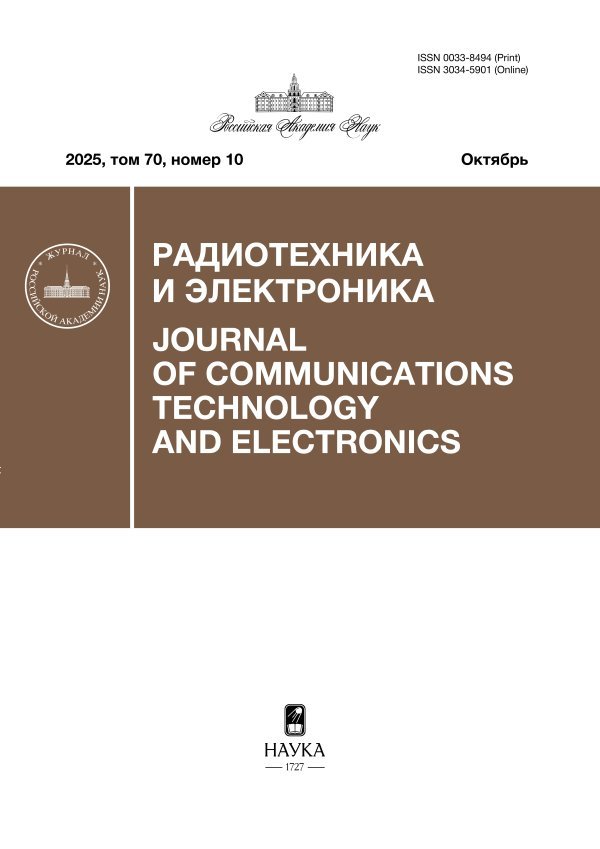Spatial-temporal Markov models in estimation-correlation-compensation signal processing in discrete time
- Authors: Kostrov V.V.1,2, Parshin Y.N.3
-
Affiliations:
- Murom Institute (branch) of Vladimir State University named after Alexander Grigoryevich and Nikolai Grigoryevich Stoletov
- JSC Research Institute Submicron
- Ryazan State Radio Engineering University named after V.F. Utkin
- Issue: Vol 69, No 8 (2024)
- Pages: 741-753
- Section: К 90-ЛЕТИЮ М.С. ЯРЛЫКОВА
- URL: https://rjsvd.com/0033-8494/article/view/684805
- DOI: https://doi.org/10.31857/S0033849424080049
- EDN: https://elibrary.ru/HORIQI
- ID: 684805
Cite item
Abstract
An algorithm for spatial-temporal signal processing in discrete time is obtained. The estimation-correlation and estimation-correlation-compensation options for constructing optimal algorithms are considered, which also makes it possible to generalize to non-Markov signals and interferences. It is shown that in order to implement the obtained algorithms, it is necessary to use extrapolation one-step estimates of the signal and interference. It is established that the interference compensator is part of the optimal estimation-correlation-compensation algorithm. The application of the proposed approach makes it possible to obtain a variety of quasi-optimal algorithms for signal detection and parameter estimation. The resulting structures are convenient for implementation in digital form by hardware and software. A spatial-temporal estimation-correlation algorithm for processing the atmospheric signal has been obtained, which allows estimating the distance to a thunderstorm discharge taking into account the height of the observation point. The influence of the number of field components on the measurement error of the distance to the lightning discharge is investigated. To improve the accuracy of distance determination, it is proposed to use a three-component field model.
About the authors
V. V. Kostrov
Murom Institute (branch) of Vladimir State University named after Alexander Grigoryevich and Nikolai Grigoryevich Stoletov; JSC Research Institute Submicron
Author for correspondence.
Email: kostrov.46@mail.ru
Russian Federation, 23 Orlovskaya str., Murom, Vladimir region, 602264; Georgievsky Ave., 5, bld. 2, Moscow, Zelenograd, 124498
Yu. N. Parshin
Ryazan State Radio Engineering University named after V.F. Utkin
Email: kostrov.46@mail.ru
Russian Federation, 59/1 Gagarina str., Ryazan, 390005
References
- Колмогоров А.Н. // Изв. АН СССР. Сер. Матем. 1941. Т. 5. № 1. С. 3.
- Папалекси Н.Д. Радиопомехи и борьба с ними. М.;Л.: Гостехиздат, 1944.
- Котельников В.А. Теория потенциальной помехоустойчивости. М.: Радио и связь, 1998.
- Харкевич А.А. Борьба с помехами. М.: Физматгиз, 1965.
- Шеннон К. Работы по теории информации и кибернетике. М.: Изд-во иностр. лит., 1963.
- Стратонович Р.Л. // Теория вероятностей и ее применение. 1959. Т. 4. Вып. 2. С. 239.
- Стратонович Р.Л. // РЭ. 1960. Т. 5. № 11. С. 1751.
- Kalman R.E. // Trans. ASME J. Basic Eng. 1960. V. 82D. March. P. 34.
- Kalman R.E., Bucy R.S. // Trans. ASME J. Basic Eng. 1961. V. 83D. March. P.95.
- Стратонович Р.Л., Сосулин Ю.Г. // Изв. АН СССР. Техническая кибернетика. 1964. № 6. C. 10.
- Стратонович Р.Л., Сосулин Ю.Г. // РЭ. 1966. Т. 11. № 4. С. 497.
- Сосулин Ю.Г. // РЭ. 1969. Т. 14. № 12. С. 2136.
- Kailath T. // IEEE Trans. 1969. V. IT-15. № 1. P. 350.
- Сосулин Ю.Г. // Изв. вузов СССР. Радиофизика. 1971. Т. 14. № 10. С. 1526.
- Стратонович Р.Л. Избранные вопросы теории флуктуаций в радиотехнике. М.: Сов. радио, 1961.
- Стратонович Р.Л. Условные марковские процессы и их применение к теории оптимального управления. М.: Изд-во МГУ, 1966.
- Стратонович Р.Л. // ТИИЭР. 1970. Т. 58. № 5. С. 72.
- Стратонович Р.Л. Принципы адаптивного приема. М.: Сов. радио, 1973.
- Амиантов И.Н. Избранные вопросы статистической теории связи. М.: Сов. радио, 1971.
- Ван Тpис Г. Теория обнаружения, оценок и модуляции. В 3-х т. М.: Сов. радио, 1972. Т. 1. 1975. Т. 2. 1977. Т. 3.
- Сосулин Ю.Г. Теория обнаружения и оценивания стохастических сигналов. М.: Сов. радио, 1978.
- Сосулин Ю.Г., Фишман М.М. Теория последовательных решений и ее применения. М.: Радио и связь, 1985.
- Сосулин Ю.Г. Теоретические основы радиолокации и радионавигации: Учеб. пособие для вузов. М.: Радио и связь, 1992.
- Тихонов В.И. Статистическая радиотехника. М.: Сов. радио, 1966.
- Тихонов В.И., Кульман Н.К. Нелинейная фильтрация и квазикогерентный прием сигналов. М.: Сов. радио, 1975.
- Тихонов В.И. Оптимальный прием сигналов. М.: Радио и связь, 1983.
- Тихонов В.И., Харисов В.Н. Статистический анализ и синтез радиотехнических устройств и систем: Учеб. пособие для вузов. М.: Радио и связь, 1991.
- Сейдж Э., Мелс Дж. Теория оценивания и ее применение в связи и управлении / Пер. с англ. под ред. Б.Р. Левина. М.: Связь, 1976.
- Kailath T. Lectures on Wiener and Kalman Filtering. Berlin: Springer-Verlag, 1981.
- Kailath T., Poor H.V. // IEEE Trans. 1998. V. IT-44. № 6. P. 2230.
- Optimised Radar Processors / Ed. A. Farina. L.: Perigrinus, 1987.
- Poor H.V. An Introduction to Signal Detection and Estimation. N.Y.: Springer-Verlag, 1988.
- Ярлыков М.С. Применение марковской теории нелинейной фильтрации в радиотехнике. М.: Сов. радио, 1980.
- Ярлыков М.С. Статистическая теория радионавигации. М.: Радио и связь, 1985.
- Ярлыков М.С., Миронов М.А. Марковская теория оценивания случайных процессов. М.: Радио и связь, 1993.
- Котоусов А.С., Морозов А.К. Оптимальная фильтрация сигналов и компенсация помех. М.: Горячая Линия–Телеком, 2008.
- Перов А.И. Статистическая теория радиотехнических систем. М.: Радиотехника, 2022.
- Марковская теория оценивания в радиотехнике / Под ред. М.С. Ярлыкова. М.: Радиотехника, 2004.
- Сосулин Ю.Г., Костров В.В., Паршин Ю.Н. Оценочно-корреляционная обработка сигналов и компенсация помех. М.: Радиотехника, 2014.
- Сосулин Ю.Г., Костров В.В. // РЭ. 1999. Т. 44. № 9. С. 1098.
- Сосулин Ю.Г., Костров В.В. // РЭ. 2000. Т. 45. № 7. С. 809.
- Сосулин Ю.Г., Паршин Ю.Н. // РЭ. 1981. Т. 26. № 8. С. 1635.
- Сосулин Ю.Г., Костров В.В. // РЭ. 1998. Т. 43. № 9. С. 1030.
- Сосулин Ю.Г., Костров В.В. // РЭ. 2006. Т. 51. № 9. С. 1027.
- Костров В.В. // Радиотехнич. и телекоммун. системы. 2014. № 1. С. 21.
- Кононов И.И., Петренко И.А., Снегуров В.С. Радиотехнические методы местоопределения грозовых очагов. Л.: Гидрометеоиздат, 1986.
- Гольдштейн Л.Д., Зернов Н.В. Электромагнитные поля и волны. М.: Сов. радио, 1971.
Supplementary files











